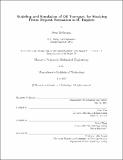| dc.contributor.advisor | Tian Tian and Victor Wong. | en_US |
| dc.contributor.author | McGrogan, Sean (Sean William) | en_US |
| dc.contributor.other | Massachusetts Institute of Technology. Dept. of Mechanical Engineering. | en_US |
| dc.date.accessioned | 2008-11-20T14:17:34Z | |
| dc.date.available | 2008-11-20T14:17:34Z | |
| dc.date.copyright | 2007 | en_US |
| dc.date.issued | 2007 | en_US |
| dc.identifier.uri | http://hdl.handle.net/1721.1/43710 | |
| dc.description | Thesis (S.M.)--Massachusetts Institute of Technology, Dept. of Mechanical Engineering, 2007. | en_US |
| dc.description | Officially submitted thesis was in in electronic form. | en_US |
| dc.description | Includes bibliographical references (p. 129-134). | en_US |
| dc.description.abstract | Carbonaceous deposits have long plagued the internal combustion engine, yet a fundamental comprehension of their underlying causes remains to be developed. In particular, piston land deposits can bring about an array of problems; for example, once a thickness threshold is crossed, the engine's reliability is threatened by an elevated possibility of seizure. As tightening emissions regulations continue to place more stringent constraints on power cylinder design, control of piston deposits, specifically in the top land and top ring groove, is becoming ever more difficult. Tests run on a heavy duty diesel engine revealed the piston land carbon deposit distribution to be circumferentially nonuniform, and a theoretical inquiry was invoked to investigate the cause. Since these deposits are typically lubricant derived, a three-dimensional, unsteady model of the oil film attached to a piston land was formulated. Focus was placed on the top land, in order to explore the effects of both reciprocating inertia and combustion-driven gas flows on the film's motion and thickness distribution. The numerical simulation created uses results from a realistic CFD simulation of the combustion process as input data. It was found that the gas velocities can have a profound effect. The gases create interesting wave structures on the free surface of the oil film, significantly altering the film thickness distribution. A new mechanism governing oil transport was discovered. Clever usage of this mechanism could substantially reduce the amount of oil, and hence the amount of deposit, on the top land. The simulation shows potential for application not only to the study of deposit formation, but also to that of oil consumption. | en_US |
| dc.description.statementofresponsibility | by Sean McGrogan. | en_US |
| dc.format.extent | 136 p. | en_US |
| dc.language.iso | eng | en_US |
| dc.publisher | Massachusetts Institute of Technology | en_US |
| dc.rights | M.I.T. theses are protected by
copyright. They may be viewed from this source for any purpose, but
reproduction or distribution in any format is prohibited without written
permission. See provided URL for inquiries about permission. | en_US |
| dc.rights.uri | http://dspace.mit.edu/handle/1721.1/7582 | en_US |
| dc.subject | Mechanical Engineering. | en_US |
| dc.title | Modeling and simulation of oil transport for studying piston deposit formation in IC engines | en_US |
| dc.type | Thesis | en_US |
| dc.description.degree | S.M. | en_US |
| dc.contributor.department | Massachusetts Institute of Technology. Department of Mechanical Engineering | |
| dc.identifier.oclc | 271676355 | en_US |
